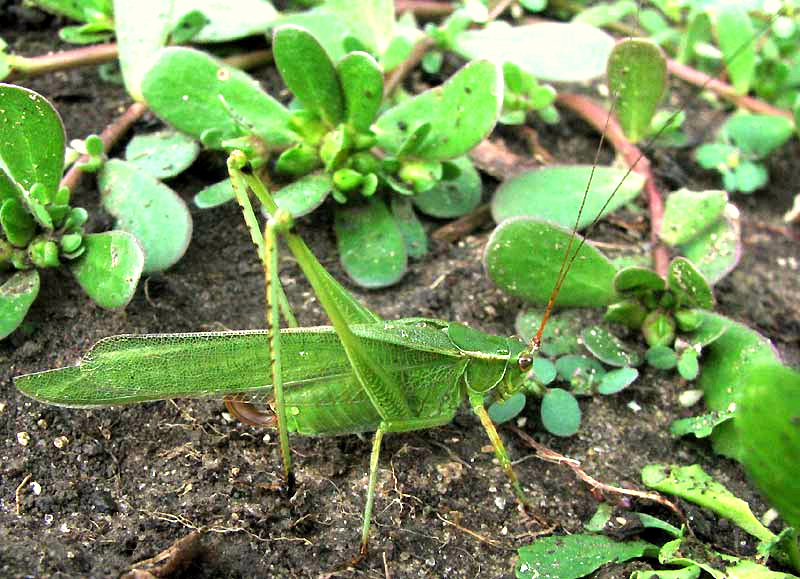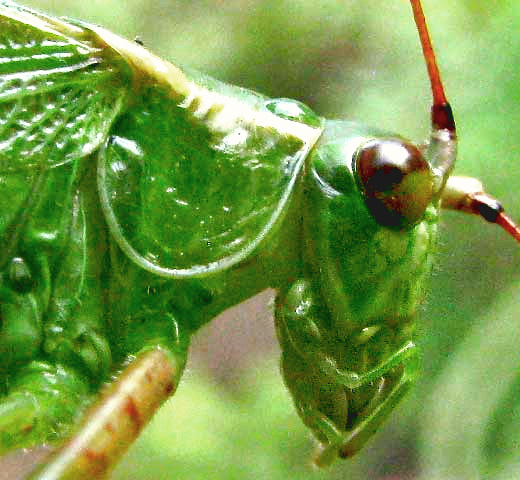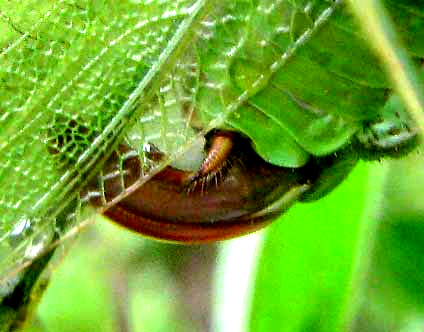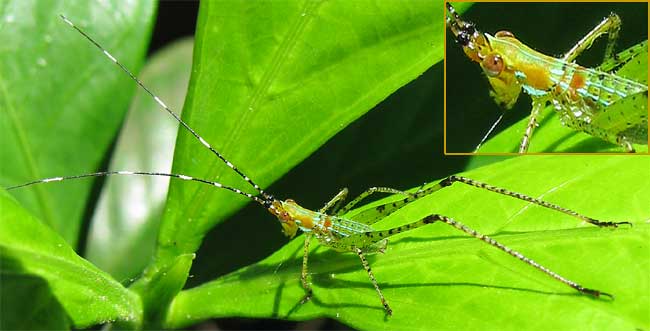Excerpts from Jim Conrad's
Naturalist Newsletter

from the October 13, 2013 Newsletter issued from the Frio Canyon Nature Education Center in the valley of the Dry Frio River in northern Uvalde County, southwestern Texas, on the southern border of the Edwards Plateau; elevation ~1750m (~5750 ft); N29.62°, W99.86°; USA
BUSH KATYDID
Some of my raised beds at the red cabin are so "weedy" with wild purslane that I didn't sow mustard or turnip greens in them -- because the wild purslane itself is even more nutritious and as good tasting as regular greens. So, early one morning I was picking greens when what I thought was a sprig of purslane jumped as I reached for it. What jumped is shown above.
A neat close-up of the head showing very complex mouthparts for chewing is shown below:

In the first picture you may have noticed that emerging from the rear end was a brown, scythe-shaped, blade-like item. A close-up of that appears below:

Probably you recognize this insect as a kind of katydid, and a female one at that, since the brown item at the rear end is the ovipositor used by the female to insert eggs into various places. Volunteer bug identifier Bea in Ontario pegs this as the Fork-tailed Bush Katydid, SCUDDERIA FURCATA, variably colored and commonly occurring throughout most of the US and adjacent Canada, south through Mexico and Central America into northern South America.
In the last picture you might have noticed at the base of the ovipositor something looking like a tiny, hairy, brownish, pointy-headed grub emerging from the same split as the ovipositor. Bea says that these as "cerci," and passes along her reading that "Cerci often serve as sensory organs, but they may also be used as weapons or copulation aids, or they may simply be vestigial structures." Seeing our katydid's cerci, I wondered whether they might enable the female to "smell" the thing she was about to lay her eggs in, and I still think that that's a good bet, though I can't find research claiming it to be so.
We've run into the Fork-tailed Bush Katydid's very attractive and interesting looking nymphal stage in Mississippi, which you can see at http://www.backyardnature.net/n/08/080707ny.jpg.
The OrthSoc.Org website provides provides pictures of the Fork-tailed Bush Katydid, and audio files of its calls.
At the same site, there's a Checklist of Katydids North of Mexico, " with links to pictures and information about a mind-boggling number of species, which is fun to browse, at.
Over 6,400 katydid species are recognized, eating mostly leaves, flowers, bark, and seeds, but many species are exclusively predatory, feeding on other insects, snails and even small vertebrates such as snakes and lizards.

from the July 7, 2008 Newsletter, issued from the forest near Natchez, Mississippi; elevation ~400ft (120m), ~N31.47°, ~W91.29°:
LILLIPUTIAN RAINBOW UNICORN
That's the name automatically coming to mind the other day when a tiny creature floated down through the air from a tree above me and settled onto my arm-hairs where it began tickling me as it wandered about. You can see what it was, with a close-up at the top right, above.
Except maybe among tropical coral reefs, have you ever seen such a colorful, delicate, retiring-looking little critter? Its body was maybe half an inch long. But, what was it?
With those long back legs obviously it was a grasshopper or something closely related. Notice that it bears no wings. Since species in the Grasshopper Order, the Orthoptera, undergo simple metamorphosis, the immature stage is referred to as a nymph, so this is clearly the nymphal stage of some orthopterous species.
In the end, with help from BugGuide.Net, I found that I had a Bush Katydid nymph, genus Scudderia. Probably it's the common SCUDDERIA FURCATA, the Fork-tailed Bush Katydid, distributed throughout most of the US wherever bushes and trees are found.